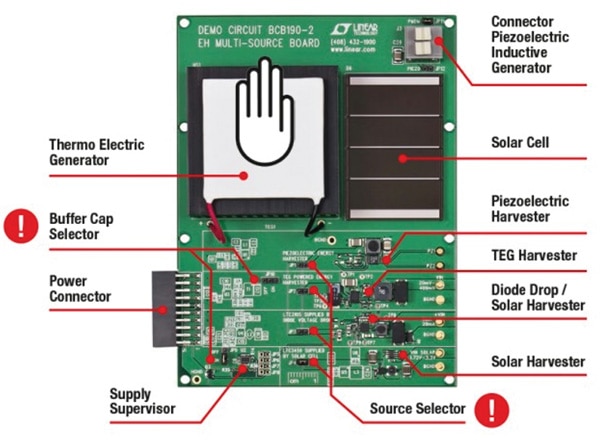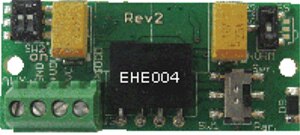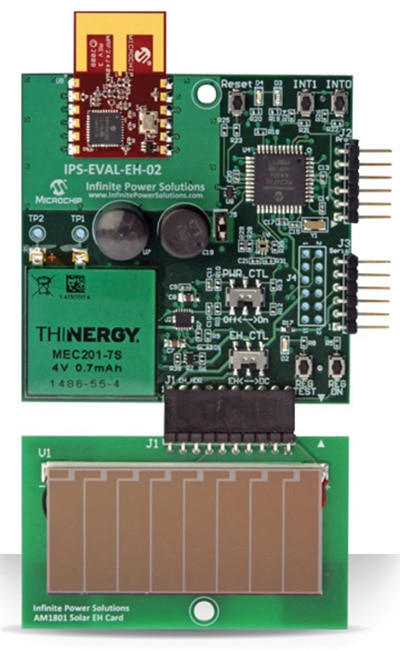Industrial Automation Ripe for Energy Harvesting to Power Wireless Sensor Networks
投稿人:DigiKey 欧洲编辑
2013-02-13
Industrial control and automation is not an obvious application for energy harvesting, although machinery, by its very nature, is an obvious source of energy, ripe for harvesting.
Nevertheless, why exploit energy harvesting in a plant or factory environment? Consider that two of the major trends affecting the industrial automation sector between now and 2015, according to Frost & Sullivan,¹ are energy efficiency (sustainability) and the integrated enterprise (networked automation). Incoming legislation for electric motors is one of the more pressing drivers of the first trend. The need to improve overall efficiency to remain competitive is stimulating the second.
So far, so good, but where does energy harvesting fit in? Wireless sensor networks have been found to deliver a host of technical, logistical, and commercial advantages in industrial monitoring, control, and automation applications. The employment of energy harvesting techniques to power these networks, thereby making them autonomous, is fast becoming a compelling dynamic. This combination of technologies can address both challenges facing the industrial automation sector: energy efficiency and networked automation.
This article will provide some insight into how these emerging technologies can be deployed with great advantage in control automation applications. A consideration of typical system construction will be followed by examples of complementary components that together can form a comprehensive solution. These include LTC3108/9 power management and LTC3588 power supplies from Linear Technology, ultra-low power Gecko microcontrollers from Energy Micro, MAX17710 power management IC from Maxim Integrated Products, Thinergy microenergy cells from Infinite Power Solutions, piezoelectric transducers from Midé, Ultracap supercapacitors from NessCap, and a development system combining some of these devices from Würth Electronics.
Industrial automation market
The availability over recent years of small, low cost, wireless sensors that can be reliably connected via a standards-based network has opened up a realm of new applications in areas such as smart buildings and industrial control, among many others. No longer the sole domain of remote applications, such as oil and gas pipelines, wireless systems are being increasingly installed throughout factories and plant networks to improve operational and energy efficiency.
A recent report from ARC Wireless for Process Manufacturing² predicted growth of 32% CAGR, reaching $1.1 billion in 2012. The appeal, according to ARC, is the ability to deploy sensor nodes that connect reliably to standard industrial network protocols, which themselves connect to higher-level networked process control systems.
In terms of wireless network technology, there are many industry standards emerging, some finding more appeal in certain markets, such as ZigBee in home automation. In the industrial, control and automation sector, the meshed architecture of the industry standard WirelessHART network provides a robust solution for wireless sensor networks in many installations. It has widespread and growing industry support and a substantial ecosystem of suppliers.
Market researchers cite WirelessHART as the most prolific wireless protocol used in industrial applications. Further, the recent announcement that the Hart Communication Foundation, Fieldbus Foundation, and Profibus & Profinet International have joined forces to ensure standard bi-directional communication between their systems has increased manufacturer confidence in the technology.
The ability to install autonomous wireless sensor networks, which harvest energy from ambient sources, in industrial control applications is the critical factor here. Whether the wireless network protocol used for the wireless sensor network is one of the many industry standards available, or whether it transmits directly to the WirelessHART network, is less material.
Convenient and cost-effective
Industry experts estimate that wiring and installation can account for 90% of the total cost of installing a typical industrial device. Retrofitting modern control and monitoring systems, or upgrading systems to improve control strategies or meet new legislation, can prove difficult because of wiring issues.
Therefore, it makes sound financial sense to consider wireless systems. Installation is dramatically simplified with no wiring, while sensor nodes can now be placed in locations and on equipment previously inaccessible under a wired system, as well as on mobile units. Systems can be just as easily reconfigured, which is a boon in factories where production lines and processes are constantly changing.
It is not only convenient, but also cost-effective to power these sensors using an energy-harvesting source. Maintenance is easier, as batteries seldom, if ever, need replacing, while trouble-shooting, diagnosis, and locating problem nodes is automatic via the network. Having the wireless sensor network operating autonomously from the equipment it is monitoring can also be an advantage. Wireless sensor networks are lower power than wired equivalents, and when powered by energy harvesting, the savings increase further. However, this is not necessarily the primary advantage.
The greater benefits accrue by exploiting the data collected by these autonomous wireless sensor networks. Wireless networks for electric motor sensing, control, and maintenance are readily available. The range of sensors that can be incorporated into networks is huge. Systems can be configured to monitor temperature, pressure, motor speed, vibration, flow rate, humidity, gases, power surges, lightning strikes, proximity, and other parameters in equipment and processes.
Sensor networks can be combined with video cameras and scene recognition software to allow new ways of controlling and monitoring. Today’s fast, low-power communications protocols support the streaming of video data, expanding yet further the applications potential into areas that need constant visual monitoring and immediate response to failures, accidents, or tampering, for example.
Not only can wireless sensor networks provide instant alarms, but also analyzing the data gathered from system monitoring can be used to improve process or production efficiency, reduce energy requirements, reduce waste, and reduce machine downtime by identifying wear and repair factors in a timely manner.
Harvesting and storing energy
Most machinery with moving parts and equipment incorporating electric motors is ideal for harvesting or scavenging energy. The primary sources include energy generated from temperature differential, mechanical and kinetic energy, all inherent to machinery.
Thermo-Electric Generators (TEGs) harvest electrical energy from thermal gradients between hot and cold processes and the ambient air. Mechanical movement, such as machine or motor vibrations can be converted into electrical energy, using a variety of transducer type devices. Piezoelectric transducers generate electricity from mechanical sources when placed under stress. Solar and photovoltaic systems are less feasible, but potentially useful in certain industrial control and monitoring applications.
Wireless sensor networks can be wholly powered by energy harvested and harnessed from machinery and plant systems. Each sensor node on the network typically comprises an energy-harvesting unit, sensors and an energy storage unit, together with their associated microcontrollers, RF circuitry, and power management devices. However, despite being extremely low power, wireless sensor networks usually require more power at peak times, such as when transmitting data on the network, than can be generated by the energy harvesting device. For this reason, an energy storage device is usually an essential component.
Furthermore, energy sources such as photovoltaic cells and vibrating machinery may only be operational intermittently. TEGs will not be generating energy when systems are cooling down, for example. Therefore, energy-harvesting systems generally store energy as it is generated, in order to use it when the energy source is passive.
Typically, the energy harvested is stored in a battery or supercapacitor. The power management device determines when and how the storage device delivers sufficient power to activate the microcontroller to perform the task, for example, to take a measurement or transmit the data captured by the sensor.
Some energy storage devices, which can last a decade or more before needing to be replaced, can outlive the application. The importance of energy storage devices in most systems cannot be over-emphasized.
In many applications, either a battery or a super-capacitor is sufficient. However, in some cases, both may be necessary, particularly if the ambient energy source is intermittent. If a system requires regular peak power bursts, it can be configured such that the battery charges the supercapacitor as required. However, if the system needs to operate in response to random or unforeseen events, a different configuration may be required. A battery may also be installed for back-up or fail-safe requirements, and may seldom, or never, be used.
Power management
However, whatever the energy source and the application need, some sort of power management is essential for autonomous operation. The electrical power output of most energy harvesting devices is unregulated. When selecting a voltage regulator, it is important to consider that if the input voltage barely exceeds the desired output voltage, then a low drop out (LDO) linear voltage regulator is required.
A power management system converts the output voltage and current of the energy-harvesting device to match the requirements of the sensor, processor, and transmitter. In addition, it ensures a smooth transition of energy, as needed, between the harvester and the storage device. Power management ICs and low drop out voltage regulators are available from a number of manufacturers.
Depending on the difference between power generated and the power needed, engineers might consider incorporating booster devices, specifically designed to amplify the low voltages generated by energy harvesters using piezoelectric, TEG, and photovoltaic sources. Several vendors of power management ICs incorporate boost converter devices for energy harvesting applications.
Ultra-low power microcontrollers and RF circuitry are now available. Modern designs feature deep sleep as well as standby modes, with both states capable of running various functions. With such devices, a typical sensor node’s power consumption may be 1 to 5 µW in standby mode, 500 µW in active mode, and may require a power peak of 50 mW to transmit data. With typical energy harvesting devices generating power in the 10 µW to 1 mW range, it becomes clear that designers must ascertain system power requirements, depending on the application.
Interestingly, vendors are teaming up to offer complementary and proven compatible solutions and evaluation/development kits, combining energy harvesting sources, microcontroller, power management IC, and energy storage.
Energy harvesting solutions
Würth Electronics, for example, has partnered with Linear Technology and European microcontroller company, Energy Micro to provide a complete energy harvesting kit solution (Figure 1).

Figure 1: The multi-source harvester board from Würth Electronics.
The complete package, Energy Harvesting Solution To Go, is compiled by Würth Electronics. The kit comprises a multi-source energy harvester board, based primarily on devices from Linear Technology, and an energy-harvesting development kit from Energy Micro, based on its Giant Gecko microcontroller.
The harvester board offers four sources: solar cell, Peltier element (TEG), piezo element, and inductive generator. The TEG harvester incorporates the LTC3108 ultra-low voltage step up converter and power manager. Operating from inputs as low as 20 mV, the device is a complete energy harvesting power management system, with selectable Vout of 2.35, 3.3, 4.1 or 5 V. Additional features include low drop out voltage regulator of 2.2 V at 3 mA, for powering an external microcontroller, and power good indicator. A storage capacitor provides power when the input voltage source is unavailable.
The LTC3109 performs largely the same role but with an autopolarity topology, allowing it to operate from input voltages as low as 30 mV, regardless of polarity. This device can be used to charge a storage capacitor or battery.
Both the piezo element and the inductive generator module on the Würth multi-source harvester board are powered by Linear’s LTC3588 dedicated piezoelectric energy-harvesting power supplies. The devices integrate a low loss full wave bridge rectifier with a high efficiency buck converter, optimized for high output impedance energy sources such as piezoelectric transducers.
On the piezo module, the LTC3588-2 features an ultra-low quiescent current undervoltage lockout (UVLO) mode with a 16 V rising threshold, which enables efficient energy extraction with high open circuit voltages. The energy is transferred from the input capacitor to the output via a high efficiency synchronous buck regulator. Four output voltages, 3.45, 4.1, 4.5 and 5 V, are pin selectable with up to 100 mA continuous output current. Linear considers the device to be ideal for use with supercapacitors, and to replace batteries in industrial sensing applications.
On the piezoelectric inductive generator circuit, the LTC3588-1 features an ultra-low quiescent current undervoltage lockout model with a wide hysteresis window to allow charge to accumulate on an input capacitor until the buck converter can efficiently transfer a part of the stored charge to the output. Output voltages available are 1.8, 2.5, 3.3 and 3.6 V. The output capacitor can be selected to provide a higher output current burst to suit the application.
Linear’s LTC3588 is also the device of choice in an energy harvesting development kit produced by Midé Technology, another of Linear’s energy harvesting technology partners. The EHE004 (Figure 2) is an energy-harvesting conditioning circuit that converts the AC output from a piezoelectric energy harvester to a regulated DC output. In addition to the LTC3588-1, used for charge management and DC-DC conversion, the board includes 200 µF of storage capacitance, which can be expanded as required.

Figure 2: The EHE004 energy harvesting conditioning circuit from Midé Technology.
The kit connects directly to any of Midé’s Volture piezoelectric devices including the raw Volture vibration energy harvesters. With the EHE004, two piezoelectric wafers can be connected in series or parallel.
Midé sees applications for this circuit in industrial health monitoring network services, condition-based maintenance sensors, and wireless HVAC sensors, among others.
Among Linear’s energy-harvesting partners for microcontrollers is European company Energy Micro. Designed specifically for ultra-low power applications, the Energy Micro portfolio of 32-bit microcontrollers includes the EFM32 Gecko family.
Described as the world’s most energy-friendly microcontroller, the device is based on an ARM Cortex M3 core, running at 48 MHz, complete with flash and ram memory, LCD controller and USB interface. In deep sleep mode, it runs at 1.1 µA, yet still has various functions running. Power consumption in active mode is just 200 µA/MHz.
The Giant Gecko Starter Kit contains a development board featuring the EFM32 Giant Gecko, 160 segment LCD, two programmable button switches a touch slider, ambient light sensor, inductive-capacitive metal sensor, 32 Mbytes of NAND flash and a 30 µF supercapacitor. All the necessary development tools for programming and debugging, including code examples, software libraries, and application notes, are also available.
Power management and storage
Another partnership has evolved between Maxim Integrated and Infinite Power Solutions, combining sophisticated power management and energy storage. The MAX17710 is designed to harvest energy from poorly regulated sources as well as maximize, protect and control that energy. The device harvests energy from 1 µW to 100 mW, and handles input source voltages higher than the energy storage device by regulating or shunting excess power. The power management IC integrates an input boost regulator, amplifying charges from as low as 800 mV. It includes an ultra-low quiescent current LDO, with selectable voltages of 1.8, 2.3, or 3.3 V.
The MAX17710 works efficiently and effectively with Thinergy microenergy cells (MECs) from Infinite Power Solutions, protecting them from the vagaries of unconventional power sources. The Thinergy MECs efficiently store energy harvested from ambient environments, such as RF, magnetic, heat, and vibration.
The company offers a comprehensive evaluation kit, IPS-EVAL-EH-02 (Figure 3), ideal for demonstrating sensing, energy harvesting, energy storage, and power regulation. The kit demonstrates the sensing of ambient temperature, humidity, luminosity, MEC voltage and occupancy, and uses an amorphous silicon solar panel as the energy source. While not designed specifically for industrial control applications, it does illustrate the effectiveness of the MAX17710 power management IC and energy storage devices, which have a battery capacity of 700 µAh. The board also utilizes the MiWi RF protocol from Microchip to transmit sensor data to a PC.

Figure 3: The wireless sensor energy harvesting evaluation kit, using Thinergy microenergy cells, from Infinite Power Solutions.
The supercapacitor is the final element to mention in the energy harvesting solution. This energy storage device can be an alternative or complementary to a battery. A popular choice for energy harvesting applications is the range of capacitors from NessCap. These small, radial, CAN, EDLC (electric double layer capacitor) devices are available in operating voltages from 2.3 to 2.7 V, and capacities from 3 F to 50 F. A typical device in the range is the ESHSR0003C0002R7, a 3 F device operating at 2.7 V, with a lifetime quoted at 87,600 h (10years) at 25°C.
Conclusion
This article has provided a brief insight into how energy harvesting technology can be applied to wireless sensor networks installed in industrial control and automation environments. The technological advantages of easy installation, convenience, low power, easy reconfigurability, and cost effectiveness are supplemented by additional benefits from gathering the sensor data, such as being able to improve productivity, reduce machine downtime, and react faster to problems.
References:- Frost & Sullivan report on Industrial Automation & Process Control Industry, May 2012
- ARC Advisory Group report on Wireless Devices in Process Manufacturing, March 2012

免责声明:各个作者和/或论坛参与者在本网站发表的观点、看法和意见不代表 DigiKey 的观点、看法和意见,也不代表 DigiKey 官方政策。








